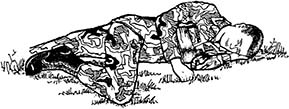- (1) Tear open one end of the casualty’s plastic wrapper covering the field dressing. Be careful not to destroy the wrapper and DO NOT touch the inside of the wrapper.
- (2) Remove the inner packet (field dressing).
- (3) Complete tearing open the empty plastic wrapper using as much of the wrapper as possible to create a flat surface.

Figure 3-2. Open chest wound sealed with an occlusive dressing.
- (1) Use your free hand and shake open the field dressing (Figure 3-3).
-

Figure 3-3. Shaking open the field dressing. - (2) Place the white side of the dressing on the plastic wrapper covering the wound (Figure 3-4).
-

Figure 3-4. Field dressing placed on plastic wrapper.NOTE
Use the casualty’s field dressing, not your own.
- (3) Have the casualty breathe normally.
- (4) While maintaining pressure on the dressing, grasp one tail of the field dressing with the other hand and wrap it around the casualty’s back. If tape is available, tape three sides of the plastic wrapper to the chest wall to provide occlusive type dressing. Leave one side untapped to provide emergency escape for air that may build up in the chest. If tape is not available, secure wrapper on three sides with field dressing leaving the fourth side as a flap.
- (5) Wrap the other tail in the opposite direction, bringing both tails over the dressing (Figure 3-5).
-

Figure 3-5. Tails of field dressing wrapped around casualty in opposite direction. - (6) Tie the tails into a square knot in the center of the dressing after the casualty exhales and before he inhales. This will aid in maintaining pressure on the bandage after it has been tied (Figure 3-6). Tie the dressing firmly enough to secure the dressing without interfering with the casualty’s breathing.
-

Figure 3-6. Tails of dressing tied into square knot over center of dressing.NOTE
When practical, apply direct manual pressure over the dressing for 5 to 10 minutes to help control the bleeding.

Figure 3-7. Casualty positioned (lying) on injured side.